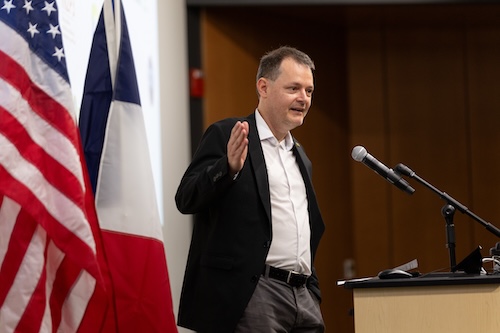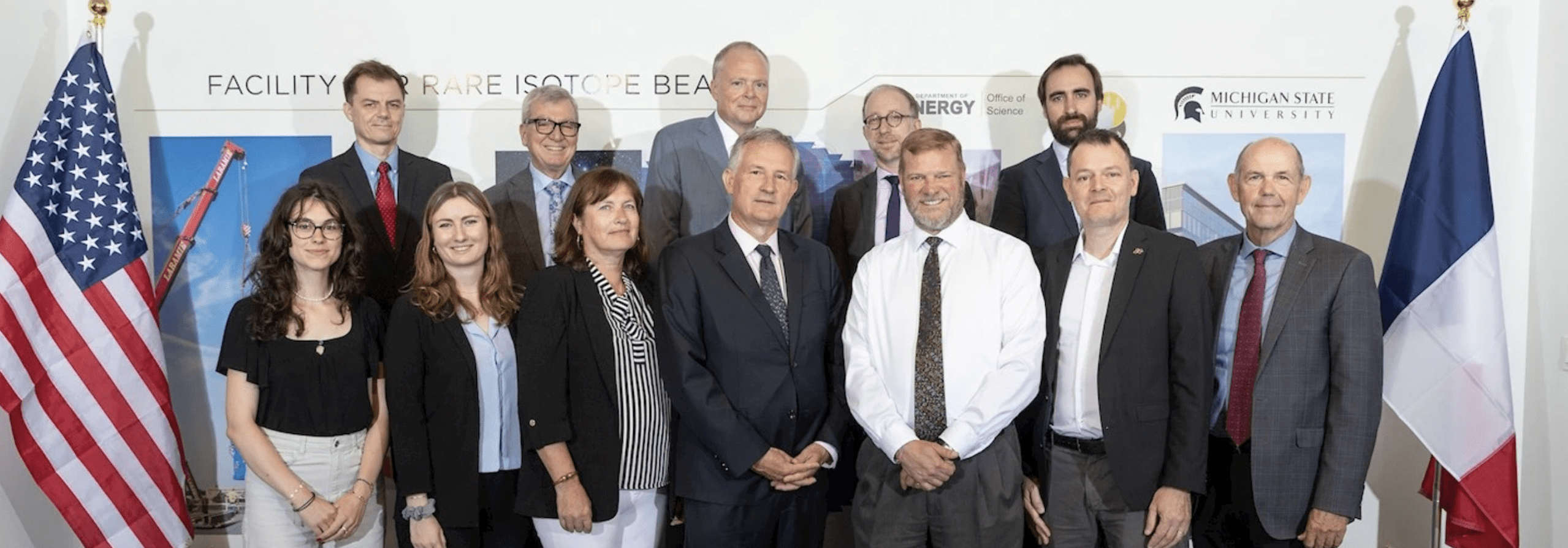Laurent Bili, the ambassador of France to the United States, visited the Facility for Rare Isotope Beams, or FRIB, at Michigan State University on 22 July.
The French research organization National Centre for Scientific Research, or CNRS, and MSU established the International Research Laboratory on Nuclear Physics and Astrophysics, or IRL NPA, at FRIB in July 2023. Leveraging FRIB’s world-unique research capabilities, IRL NPA is located at FRIB and dedicated to answering fundamental nuclear physics and astrophysics research questions.
In addition to marking the activities of the IRL NPA at MSU after one year, Bili’s visit centered on highlighting the ongoing France and U.S. efforts that advance forefront science and foster positive international relations and global impact, including many MSU/France initiatives, collaborations and programming.
“The establishment of the International Research Laboratory on Nuclear Physics and Astrophysics at FRIB last year was the beginning of an academic partnership to foster international relations to make a collective global impact,” said MSU President Kevin M. Guskiewicz, Ph.D. “As this partnership focused on nuclear physics and astrophysics research continues to grow, it shows MSU’s land-grant values with a global view — to unite diverse perspectives and expertise, develop innovative solutions to address global challenges, improve lives and build a more interconnected and better future.”
“Our countries, with their rich scientific traditions, shared values of innovation and dedication to excellence in research have long recognized that their combined efforts can achieve more than either could alone,” said Ambassador of France to the United States Laurent Bili. “It is an honor to visit Michigan State University where there are so many examples of our united efforts at work, on the one-year anniversary of one of our more recent joint endeavors — the IRL NPA at FRIB. With its recent partnerships with INRAE and CNRS, your university is an example of the diversity of scientific fields of excellence in the Midwest and of the success of the collaborations that can result from it.”
“University research programs play a crucial role in fostering innovation and collaboration on a global scale, and I believe there are many more opportunities to expand our scientific partnership and make a broader impact together with willing and collaborative partners like our French colleagues,” said Interim Provost and Executive Vice President for Academic Affairs Thomas D. Jeitschko. “Through joint research initiatives and funding opportunities, like the IRL NPA at FRIB and others at MSU, these partnerships not only enhance academic rigor but also drive significant advancements in fields such as science, technology and the humanities.”
“Through the international collaborations being enabled at IRL NPA at FRIB, we are unlocking unprecedented discovery potential in the fields of nuclear physics and astrophysics,” said FRIB Laboratory Director Thomas Glasmacher. “This partnership allows us to tackle complex scientific and technical challenges while exchanging ideas and expertise among world-leading scientists. We are honored to host His Excellency Bili to together mark the first year of this flourishing joint venture that will spur discoveries to benefit humankind.”
MSU and France partnership broad and impactful
MSU’s engagement with France is wide-ranging and impactful.
On the nuclear physics research front, CNRS and MSU researchers have long collaborated — setting the stage for the IRL NPA at FRIB — to advance forefront science. For more than 40 years, researchers from CNRS, FRIB and FRIB’s predecessor (the National Superconducting Cyclotron Laboratory, or NSCL) have collaborated on research projects that have yielded enduring results and relationships to advance science. Examples include:
- In research involving the Active Target Time Projection Chamber, or AT-TPC, a detector at FRIB, there is a long history of collaboration with French institutions. A large collaboration of MSU/NSCL with the CNRS and the French Alternative Energies and Atomic Energy Commission (CEA Saclay), particularly around the Large Heavy Ion Accelerator (GANIL), developed General Electronics for TPCs (GET). The group worked for a decade to develop the GET system, which was an exceptional and successful development, now used internationally in France, Japan and Korea, and in the U.S. at FRIB, Notre Dame and Texas A&M.
- One recent example of the enduring research collaborations is the search for dark matter in the decay of helium-6, explored in a Physical Review Letters paper published earlier this year. Additional research collaborations over time have focused on improving instrumentation and modeling.
- In theoretical nuclear physics, longstanding collaborations with CNRS researchers on fundamental interactions have paved the way for future FRIB collaborations in this specific research area. And through additional ongoing collaborations with French researchers from CEA Saclay, FRIB theorists are developing advanced new methods for simulating nuclei, with applications ranging from predicting the limits of nuclear existence to understanding the formation of elements in the cosmos or providing important information for efforts that test the fundamental symmetries of nature.
- Training scientists has been an integral part of the collaborative relationship between NSCL/FRIB and France, as illustrated by many internships involving French universities like Grenoble INP – Phelma, Université Grenoble Alps, and ISAE‑Supméca.
In addition to the collaboration in nuclear physics at FRIB, MSU currently has 12 active research grants in collaboration with or in support of French projects. The research spans disciplines such as physics and astronomy, creating more sustainable packaging systems and developing more stress-tolerant plants. Foci on human and animal health research includes regulation of endometriosis, mechanisms of genetic damage and wound repair in mammals.
MSU is an active participant in the International Research Experience Program, or IREP, which facilitates short-term research internships between a consortium of 22 French universities and participating Big Ten universities.
A longstanding collaboration with the University of Montpellier in France enables student exchanges for research and training stays. The collaboration also involves researchers from INRAE (France’s National Research Institute for Agriculture, Food and the Environment), and MSU hosts an International Associated Laboratory with INRAE, to research molecular mechanisms involved in plant mineral nutrient adaptation to climate change.
Part of MSU’s No. 1 ranking for education abroad among public universities, according to U.S. News and World Report, is due to MSU’s more than 300 education abroad programs, with 16 programs involving France. About 300 MSU students participate annually in education abroad and exchange programs in France.
Additionally, in arts programming, MSU hosts the Albertine Cinémathèque French Film Festival.

IRL NPA at FRIB thriving after one year
Since its establishment in July 2023, the IRL NPA is thriving, with research collaborations, new programming and student training opportunities underway. In December 2023, IRL NPA held its inaugural science meeting at FRIB to consolidate existing collaborations and launch new ones, as well as share new proposals and ideas for opportunities to work together.
As a result, CNRS scientists have participated in three experiments at FRIB. The experiments explored topics including how quickly aluminum-25 can capture a proton inside stars, understanding heating and cooling processes in neutron star crusts, and examining electromagnetic radiation. While the experiments were already planned before the IRL NPA was established, the IRL NPA facilitated CNRS researchers’ participation — an intended impact of the laboratory. Planning is also underway for upcoming workshops and education and training opportunities. Additionally, researchers from GANIL and FRIB are working on instrumentation advancements that will benefit the scientific work at both facilities. One current project involves the Advanced Rare Isotope Separator at FRIB, and another is the development of the Superconducting Electron Cyclotron Resonance Ion Source in collaboration with GANIL.
“The long-standing connections between CNRS and MSU have paved the way for innovative arrangements like the IRL NPA at FRIB, which is thriving in its first year, like our many other IRLs that have proven a successful framework for collaborative discovery,” said Antoine Petit, chairman and chief executive officer of the CNRS. “The IRL NPA not only unites researchers from France and the U.S. but also stands as a testament to our commitment to fostering scientific breakthroughs through collaboration and innovation. Together, we are shaping the future of science through shared knowledge and collaboration.”
IRL NPA is permanently staffed with French scientists dedicated to answering fundamental nuclear physics and astrophysics research questions. CNRS has nearly 80 international research laboratories worldwide, and IRL NPA at FRIB is the first dedicated to nuclear physics and astrophysics.
“IRL NPA at FRIB is off to a tremendous start in creating an enduring collaborative, global research structure, particularly between SPIRAL2 at GANIL in France, and FRIB,” said IRL NPA Director and CNRS researcher Jérôme Margueron. “By bringing together diverse international institutions that share similar features, we are gaining in technology and time by exchanging ideas and collaborating. I have no doubt that the synergy of our combined expertise will lead to groundbreaking advancements that will foster our field, enriching both our understanding and the future of science.”

MSU has been a place of scientific discovery and a worldwide leader in nuclear science and astrophysics for more than half a century. FRIB and its predecessors have enabled discoveries in nuclear science and astrophysics with accelerated beams of atoms for more than 40 years at MSU. Additionally, MSU has been a top-ranked nuclear physics graduate program for 29 years, according to U.S. News and World Report, and awards 15% of nuclear physics doctorate degrees each year.
MSU operates FRIB as a user facility for the U.S. Department of Energy Office of Science, or DOE-SC, supporting the mission of the DOE-SC Office of Nuclear Physics. FRIB enables scientists to make discoveries about the properties of rare isotopes in order to better understand the physics of nuclei, nuclear astrophysics, fundamental interactions and applications for society, including in medicine, homeland security and industry. FRIB supports a user community of 1,800 scientists from around the world, representing 53 countries, including France.
This story was originally published by the Office of Research and Innovation.
About the MSU Innovation Center:
The MSU Innovation Center is dedicated to fostering innovation, research commercialization, and entrepreneurial activities from the research and discovery happening across our campus every day. We act as the primary interface for researchers aiming to see their research applied to solving real-world problems and making the world a better place to live. We aim to empower faculty, researchers, and students within our community of scholars by providing them with the knowledge, skills, and opportunities to bring their discoveries to the forefront.
Through strategic collaborations with the private sector, we aim to amplify the impact of faculty research and drive economic growth while positively impacting society. We foster mutually beneficial, long-term relationships with the private sector through corporate-sponsored research collaborations, technology licensing discussions, and support for faculty entrepreneurs to support the establishment of startup companies.
Is your organization interested in collaborating with FRIB researchers? Click Here.



